新目标九年级英语Unit5第五课时课件
- 格式:ppt
- 大小:488.50 KB
- 文档页数:31
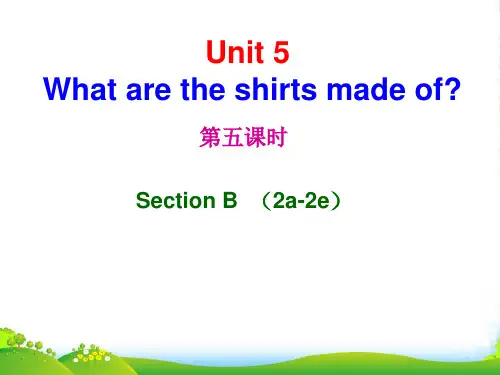
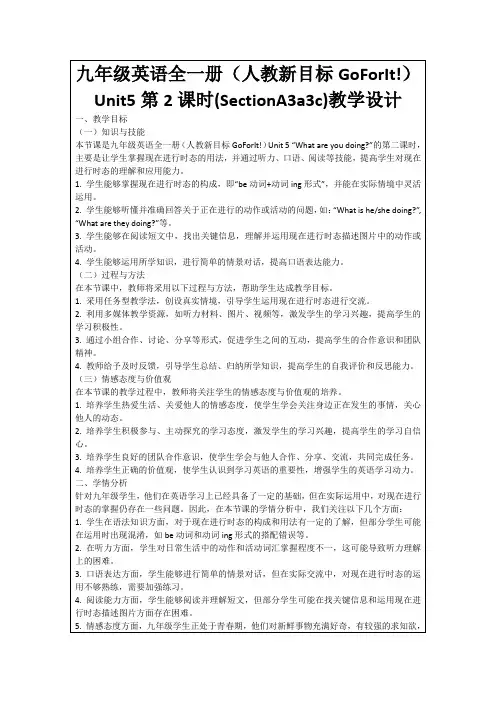
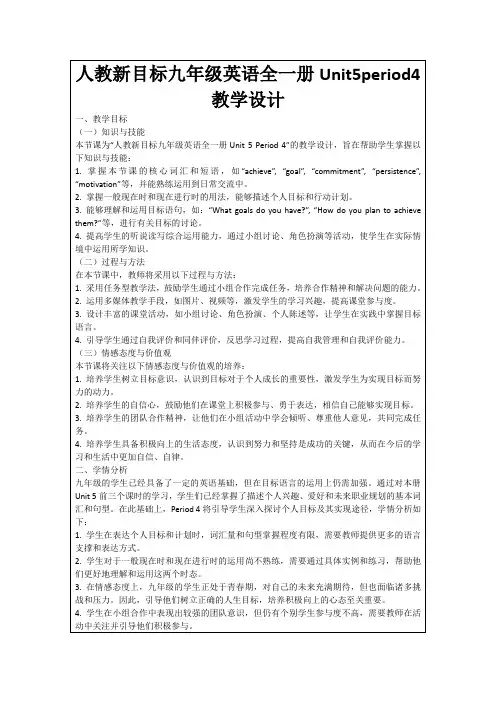
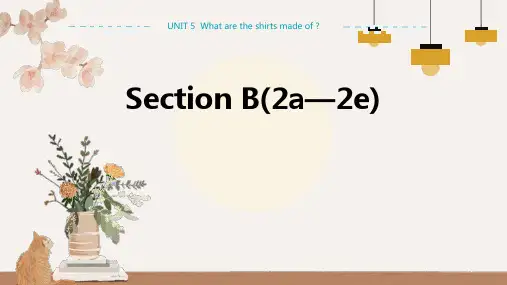
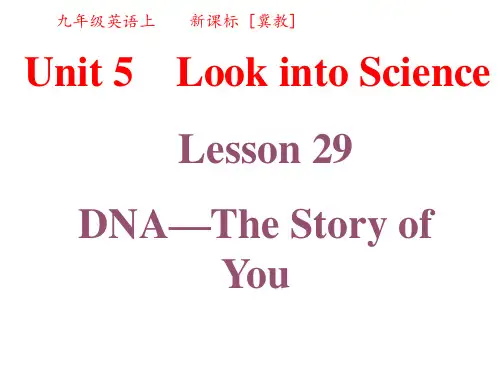
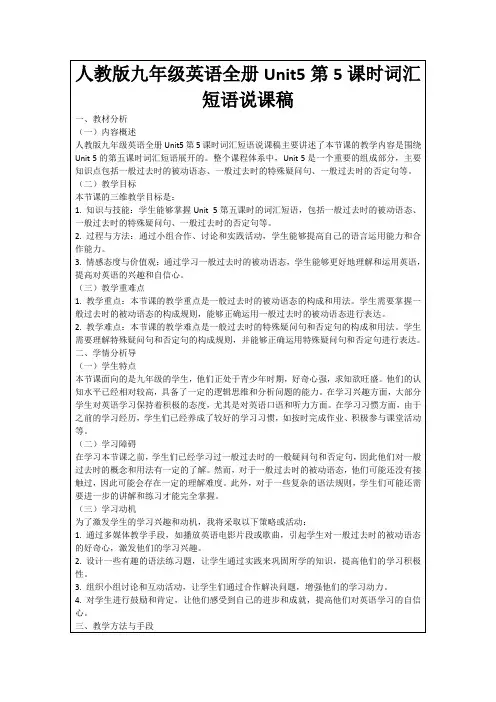
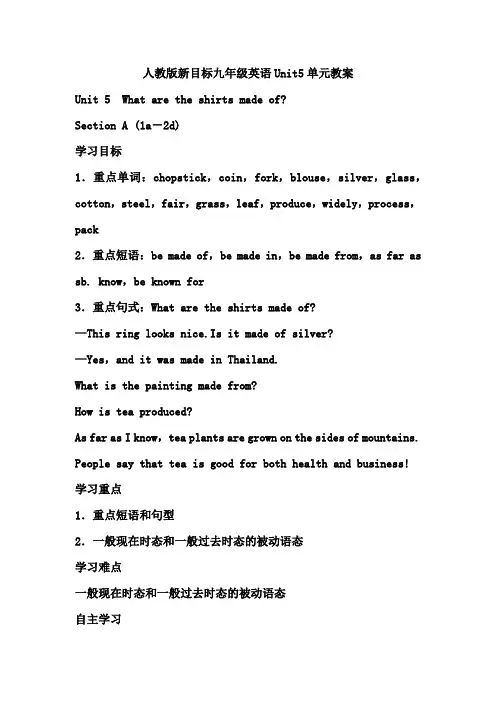
人教版新目标九年级英语Unit5单元教案Unit 5 What are the shirts made of?Section A (1a-2d)学习目标1.重点单词:chopstick,coin,fork,blouse,silver,glass,cotton,steel,fair,grass,leaf,produce,widely,process,pack2.重点短语:be made of,be made in,be made from,as far as sb. know,be known for3.重点句式:What are the shirts made of?—This ring looks nice.Is it made of silver?—Yes,and it was made in Thailand.What is the painting made from?How is tea produced?As far as I know,tea plants are grown on the sides of mountains. People say that tea is good for both health and business! 学习重点1.重点短语和句型2.一般现在时态和一般过去时态的被动语态学习难点一般现在时态和一般过去时态的被动语态自主学习一、预习课本P33-34新单词并背诵,完成下面的汉译英。
1.筷子________ 2.硬币________3.叉子________ 4.衬衫________5.银器________ 6.玻璃________7.棉花________ 8.钢铁________9.展览会________ 10.草地________11.叶子________ 12.生产________13.普遍地________ 14.加工________15.包装________二、认真预习1a-2d找出下列短语和句型。
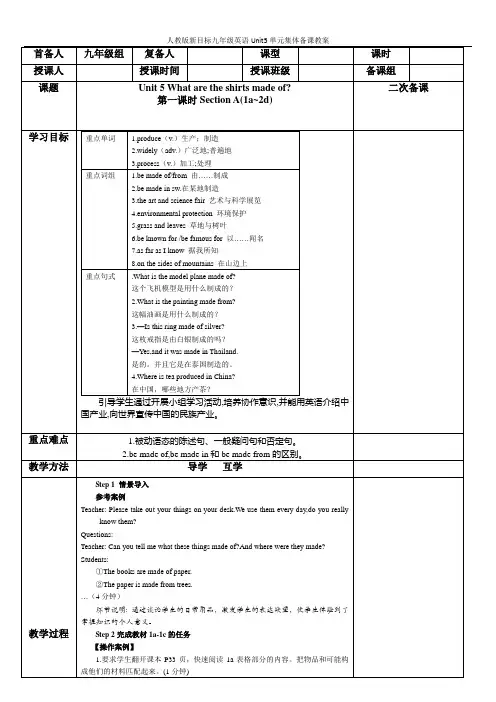
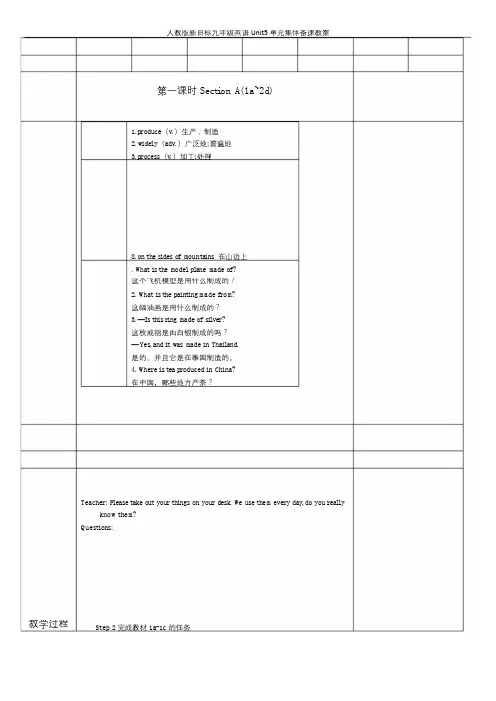
第一课时Sect i on A(1a~2d)1.produce(v.)生产;制造2.wide ly(adv.)广泛地;普遍地3.process(v.)加工;处理8.on the s ides o f mount a ins在山边上.What i s the model p lane made of?这个飞机模型是用什么制成的?2.What i s the pa in t ing made f rom?这幅油画是用什么制成的?3.—Is th i s r ing made of s i lver?这枚戒指是由白银制成的吗?—Yes,and i t was made in Tha i land.是的。
并且它是在泰国制造的。
4.Where i s t ea p roduced in China?在中国,哪些地方产茶?Teacher: P lease t ake out your th ings on your desk.We use them every day,do you rea l ly know them?Ques t ions:教学过程Step 2完成教材1a-1c的任务5.小结训练。
要求学生在规定的时间内完成一个小练习。
并请若干学生给出自己的答案。
有错误的话及时纠正。
(2分钟)用括号内所给动词的正确形式填空。
1)The apples a re sen t(send)to the fac tory f or p rocess ing.2)We are a l l r eady bu t Tom hasn’t packed (pack) h i s c lo thes ye t.3)The windows of the room are c leaned(c lean)every day.4)The bes t co t ton i s p r oduced(p roduce)in Xing J iang in China.5)The song isn’t liked (no t l ike) by mos t o f us.环节说明:通过学习1a,使学生对被动结构有所了解;通过1b,锻炼学生的听力及抓取关键信息的能力;通过1c的训练锻炼学生的口头表达能力,同时巩固对一般现在时被动结构的认识。
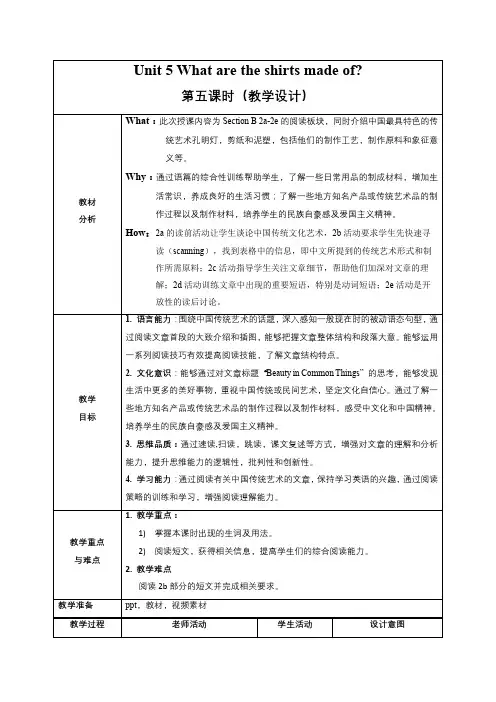
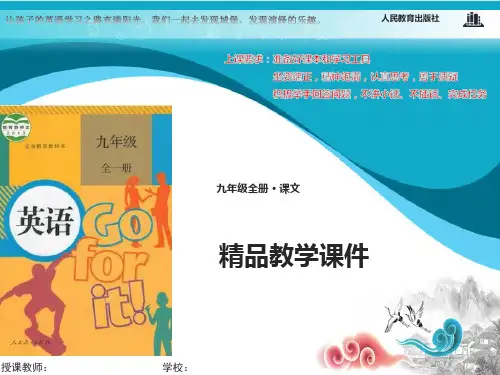
Unit 5 It must belong to Carla第一课时单元分析与提示教学目标语言目标:1、掌握情态动词must, might, could, can’t的用法;2、学会谈论自己的推理,能灵活运用以下句型的词汇:Whose book is it? It must be Tom’s. It has his name on it.Whose ruler is it? It could/might be Jim’s. He has a blue one.Whose hair band is it? It can’t belong to Mary. Mary has short hair.plate, picnic, belong to, crucial, grateful, disappear, return, lost, owner3、学会用情态动词表达能力、客观可能性以及请求、允许、猜测和征求对方的意见。
4、学会用情态动词表达某人拥有某物认知目标掌握must, might, could, can’t的用法,理解之后通过练习和运用加以巩固。
情感目标1、通过本单元学习使学生学会用自己的生活常识来判断事物。
2、培养学生的逻辑思维和推理能力。
教学重、难点1. can 和could的用法。
1)表示能力或客观可能性,还可以表示请求和允许。
Can you finish this work tonight ?Man can not live without air.2)could也可表示请求,语气较委婉,主要用于疑问句,不可用于肯定句,答语应用can,否定用No,I’m afraid not.Could I come to see you tomorrow ? Yes, you can; No, I’m afraid not3)当表达“某件事已成功”时应用was(were) able to,而不能用couldHe was able to go to the party yesterday evening and he enjoyed himself very much.4)表示惊异、怀疑、不相信的态度(主要用于否定句、疑问句或感叹句)2. may的might的用法3. shall和should的用法4. must 的否定回答用needn’tmay的否定回答用mustn’tMust I hand in my paper today ?No, you needn’t.May I keep this novel for three weeks ?No, you mustn’t教学安排4课时第一课时:Section A 1a, 1b, 1c, 2a, 2b, 2c第二课时:Section A 3a, 3b, 4第三课时:Section B 1, 2a, 2b, 2c, 3a第一课时:Section B 3b, 3c, 4 and Self CheckUnit 5 第二课时Teaching aims本课学会用情态动词表达物品的所有者Teaching of new lesson1、Ask four students to take out the things they broughtjacket, T-shirt, CD, toy car1) Ask the other studentsT: whose jacket is this ? S: Anna’s ?T: I think it could be Anna’s. It might be Anna’s. Let’s ask her. Anna, is this your jacket?S2: No, it’s not mine. It must be Lee’sT: It can’t be Anna’s. it must belong to Lee.2) Ask the students to practice the dialogue with T-shirt, CD, toy carA: Whose … is this?B: Tom’sA: I think it could be Tom’s. It might be Tom’s. Let’s ask him. Tom, is this your …… ?C: No, it’s not mine. It must be John’sT: It can’t be Tom’s. It must belong to John.3) Say: When we talk about things we’re not sure of, we use the words: could, might, can’t and must. And pay attention to the words “belong to John”, don’t say “belong to John’s”2. Point to the picture and ask:Which items in the picture do you know ?Which items are new to you ?Clothing: hat, jacket, T-shirt.Fun things: volleyball, CD, toy car, magazine, bookKitchen things: plate, cups3. Ask the students to connect the items in the three column Section A, 1b.先让学生听第一遍,按要求完成1b,更正答案J ane’s little brother - toy car --- He was the only little kid at the picnic.Mary – book - Wanda Wilbur is her favourite author.Carla – volleyball - She loves volleyballDeng Wen-magazine- He loves cats.Grace – CD – She always listens to classical music.4. Ask the students to practice using the target language.Whose, volleyball, toy car, magazine, book, CD, must be, belong to5. 2a. This activity provides listening practice using the target language.a school T-shirt, a hair band, tennis balls.Kumi’s, Linda’s, Rita’s6. 2b. This activity provides listening and writing practice using the target language written by the teacher.Must might could or can’t7. Extension利用各种各样的实物或图片,模仿听力的对话模式,让学生进行各种猜测。
河北省围场县棋盘山中学九年级英语全册《Units》(6课时)学案人教新目标版二、合作共建Taskl >模仿对话,提出邀请A: Can you come to my party on Wednesday?B: Sure, I would love to.A: Can you come to my party on Wednesday?C: Sorry, I can not」have a piano lesion.A: Can you come to my party on Wednesday?D: I am sorry, too. I h ave to go to a doctor.Task2听力练习学习1b然后连线。
Tim have a piano less on.Ted have to go to the doctor.Kay have to study for a test .Anna visit her auntWilson have to help my parents.请写岀一组邀请与被邀请的对话。
三、系统总结1、总结本课所学短语6个:2、总结进行邀请的句子。
四、诊断评价1、用动词的适当形式填空1 ) I have ____ (help) my mother.2) She __ (have) a piano lesss now.3) I would love _____ (come) to your party.4) I am sorry ____ (hear) that.5) Thank you for ______ (help) me.6) He ___ (have) to go to the doctor.2、选择_____________________________ 1 ) Can you come to my party Sun day afternoon?A > inB 、on C、at D、with2) —Can you come to party with us? —— ____________A、I would love to B 、丨would like to C 、丨would love too.3) I can not go to the party,Maybe _____ A、no time B 、other time C 、next time4) How about ___ t o the zoo? A 、goes B 、went C 、going3、翻译句子、1)你能来参加我的宴会吗?2 ) 对不起,我得帮妈妈干活。